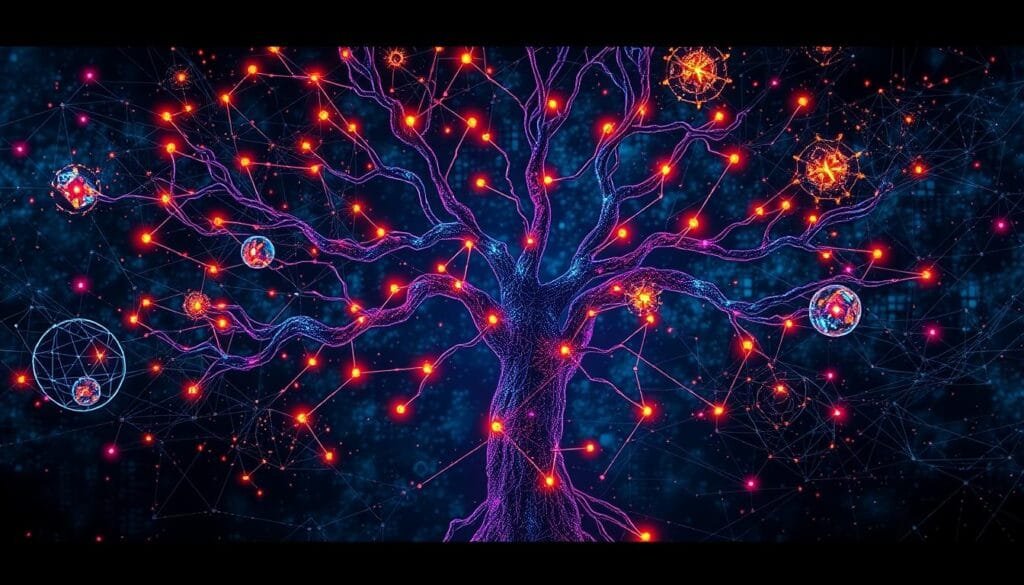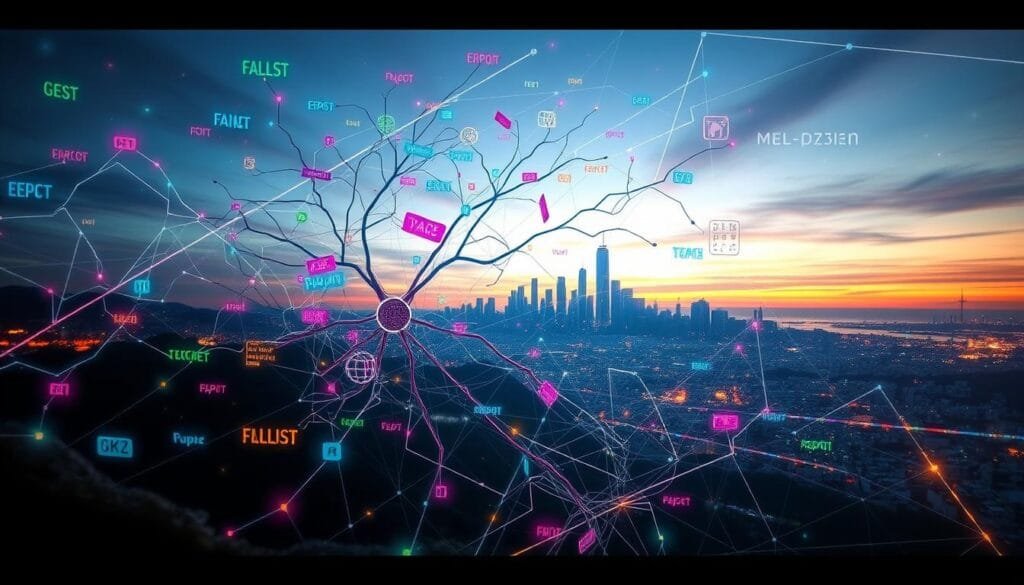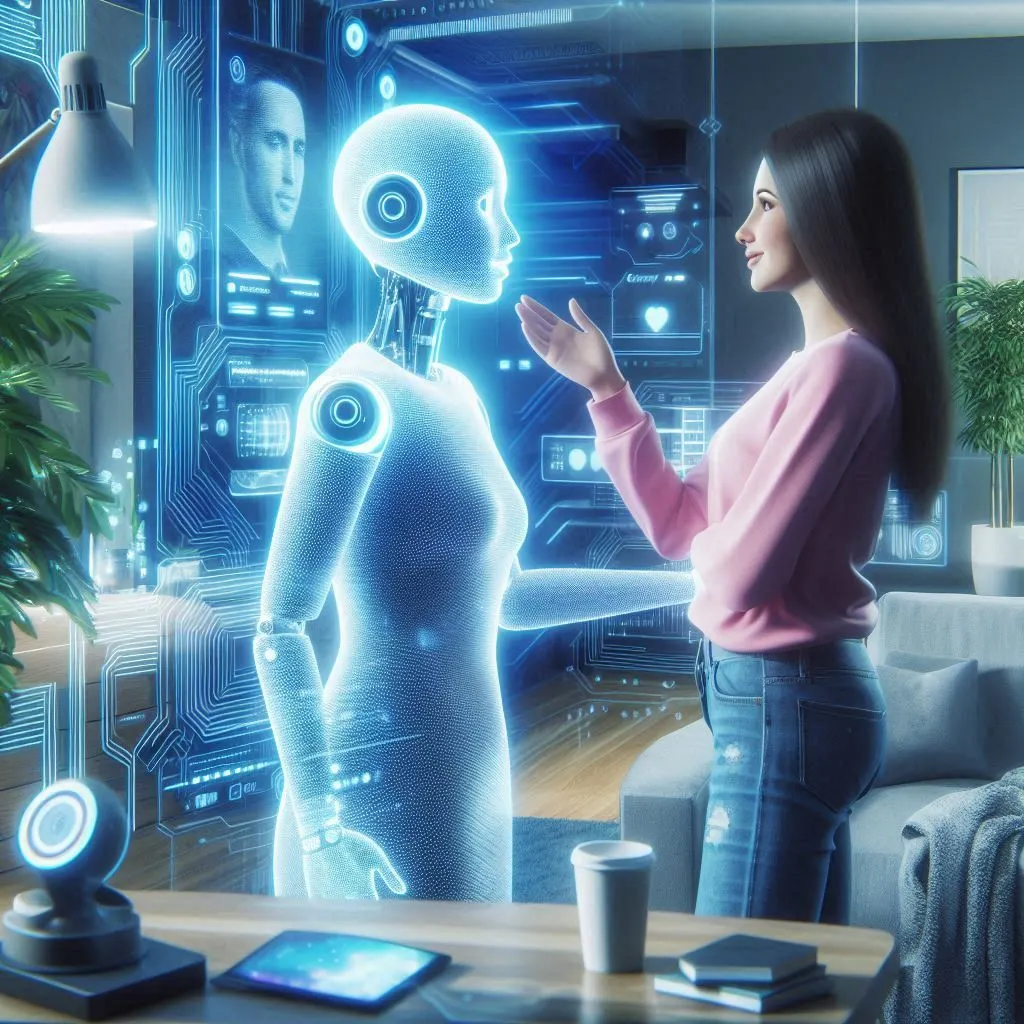The human mind and artificial intelligence (AI) systems are two different ways to process information and make decisions. As technology gets better, it’s important to know how they compare. This article will look at how humans think, the growth of AI, and the ethics of AI development.
Key Takeaways
- Explore the rational thinking and intuitive decision-making processes of the human mind.
- Understand the cognitive capabilities and limitations of human cognition.
- Analyze the strengths and drawbacks of AI systems in comparison to human reasoning.
- Examine the role of natural language processing in bridging the gap between human and machine intelligence.
- Discuss the ethical considerations in AI development, including bias and transparency.
Unveiling the Human Mind: Rational Thinking and Intuition
Exploring the human mind reveals a balance between rational thinking and intuition. Our brain is a complex marvel, full of cognitive abilities. It shapes how we see the world, from solving problems to making daily choices.
Exploring Cognitive Capabilities of the Human Brain
The human brain is incredibly powerful. It handles lots of information and solves complex problems. It uses logic and reasoning to understand our surroundings, which distinguishes our mind from artificial intelligence.
The Role of Heuristics and Logic in Human Decision Making
Our decisions mix rational thinking and intuition. Heuristics help us make quick choices when we are unsure. But, our ability to reason and solve problems also helps us face bigger challenges. This shows the human mind’s strengths and its limits compared to AI.
| Cognitive Capability | Human Mind | Artificial Intelligence |
|---|---|---|
| Heuristics and Intuition | Strong | Emerging |
| Logical Reasoning | Robust | Advanced |
| Problem-Solving Strategies | Versatile | Specialized |
| Symbolic Reasoning | Innate | Developing |
Studying the human mind and AI reveals their unique qualities. Understanding our brain’s abilities helps us work better with AI, and this knowledge is key to our future collaboration with technology.
The Rise of Artificial Intelligence: Machine Learning Algorithms
Artificial intelligence (AI) is changing how we solve problems and make decisions. At the core of this change are machine learning algorithms. They aim to improve our thinking abilities.
Machine learning algorithms use data to learn and get better over time. They can analyze huge amounts of data and make smart choices. This includes tasks like understanding language and creating neural networks.
| Machine Learning Algorithms | Applications | Advantages |
|---|---|---|
| Supervised Learning | Image recognition, speech recognition, predictive analytics | Learns through trial and error can optimize decision-making in dynamic environments |
| Unsupervised Learning | Anomaly detection, customer segmentation, recommendation systems | Discovers hidden patterns in complex data, adaptable to unstructured inputs |
| Reinforcement Learning | Game-playing, robotics, autonomous vehicles | Learns through trial-and-error, can optimize decision-making in dynamic environments |
These algorithms are getting better and better. They are changing how we think and solve problems. By working together with humans, they are helping us face big challenges.

Human Reasoning vs. AI: A Comparative Analysis
Exploring human thinking and artificial intelligence (AI) shows their unique strengths and weaknesses. Humans are great at making quick decisions, solving problems, and analyzing things deeply. On the other hand, AI is super fast, accurate, and logical.
Strengths and Limitations of Human Cognition
The human brain is amazingly able to make decisions quickly, solve problems creatively, and understand complex situations. We use our past experiences to make smart choices. But, our thinking can also be influenced by emotions and biases, leading to inconsistent logic.
Advantages and Drawbacks of AI Systems
AI systems are great at handling huge amounts of data, finding patterns, and making decisions based on facts. They solve problems and reason logically better than humans. But, AI can also have biases and not fully understand the context like humans do. It’s important to think about the ethics of AI.
Knowing the good and bad of both human thinking and AI helps us work together better. This mix of human creativity and AI’s analytical power could lead to big breakthroughs in solving problems.
Natural Language Processing: Bridging the Gap
Natural language processing (NLP) is a key tool in bridging the gap between human and artificial intelligence (AI) systems. It’s a vital part of cognitive computing. NLP lets machines understand, interpret, and create human language with great accuracy.
Understanding Language with NLP Techniques
NLP uses various techniques to help AI systems understand and interact with natural language. These include:
- Syntax Analysis: Examining the grammatical structure of language to understand the relationships between words and phrases.
- Semantic Analysis: Interpreting the meaning and context of language, beyond just the literal definitions of words.
- Text Classification: Categorizing text into predefined topics or sentiments (positive, negative, or neutral).
- Named Entity Recognition: Identifying and extracting important entities, such as people, organizations, or locations, from text.
- Machine Translation: Translating text from one language to another, preserving the original meaning and intent.
By using these NLP techniques, AI systems can understand natural language. They can respond in a way that feels human-like. This makes communication between humans and machines smoother.
| NLP Technique | Description | Key Applications |
|---|---|---|
| Syntax Analysis | Examining the grammatical structure of language | Natural language understanding, text generation, machine translation |
| Semantic Analysis | Interpreting the meaning and context of language | Sentiment analysis, intent recognition, question answering |
| Text Classification | Categorizing text into predefined topics or sentiment | Content filtering, customer service, document management |
| Named Entity Recognition | Identifying and extracting important entities from text | Information extraction, knowledge graph construction, data mining |
| Machine Translation | Translating text from one language to another | International communication, multilingual customer support, language learning |
The field of natural language processing is growing fast. It’s opening up new ways for data analysis, decision-making, and logical thinking. These advancements are changing how we solve problems and make decisions.

Ethical Considerations in AI Development
Artificial intelligence (AI) is growing fast, and we must think about its ethics. We need a strong ethical guide for AI to match human values. This part will look at key ethics in AI, like tackling bias and being clear.
Addressing Bias in AI
AI can carry and grow biases, causing unfair results. To fix this, developers must work hard to remove bias. They should pick good training data, check algorithms for bias, and include many views in AI design.
Also, AI must be clear in its choices. This transparency helps build trust and lets us check AI’s actions. It’s key for AI to be responsible for its decisions.
| Ethical Principle | Importance in AI Development |
|---|---|
| Non-discrimination | Ensuring AI systems do not perpetuate or exacerbate societal biases and discrimination |
| Transparency | Enabling accountability and explainability in AI decision-making processes |
| Human-centric Design | Prioritizing the wellbeing and interests of humans in the development and deployment of AI |
By focusing on these ethics, we can make AI that’s good and fair. This way, AI can be a powerful and trustworthy tool for us all.

Explainable AI: Demystifying Machine Decisions
In the fast-growing world of artificial intelligence (AI), explainable AI is key. It makes AI’s decision-making clear to humans. This builds trust and teamwork between humans and machines.
AI systems are getting smarter, making complex choices and doing tasks humans used to do. Now, we need rational agents that can explain their actions. Explainable AI helps us understand the logic and heuristic decision-making behind AI’s choices.
AI systems explain their decisions, helping us grasp the logic and inference behind their actions. This improves natural language understanding, data analysis, and decision-making.
Explainable AI is vital for bridging the gap between human and machine intelligence. It builds trust in AI’s abilities. As AI continues to evolve, the need for clear and accountable AI will grow, making explainable AI a top priority.
| Characteristic | Explainable AI | Traditional AI |
|---|---|---|
| Transparency | High | Low |
| Interpretability | High | Low |
| Trust | High | Low |
| Accountability | High | Low |
IBM Watson and Anthropic AI: Industry Leaders in Cognitive Computing
In the world of artificial intelligence, IBM Watson and Anthropic AI stand out. They are leading the way in cognitive computing. These advanced AI systems are changing how we think, feel, and solve problems. They offer new insights and solutions to many challenges.
Exploring Real-world Applications and Use Cases
IBM Watson is known for its contextual understanding and machine learning. It has changed many industries. In healthcare and finance, Watson analyzes data and gives personalized advice. This has helped doctors find diseases early and improve treatment plans.
Anthropic AI focuses on ethical decision-making and mitigating machine learning biases. It uses advanced algorithms and ethical frameworks. This ensures its systems make decisions that respect human values and society’s well-being.
IBM Watson and Anthropic AI are leading the way in cognitive computing. They are innovating and setting new standards for human and machine intelligence.
The Future of Human-AI Collaboration
Artificial intelligence (AI) is growing fast, making it exciting to think about humans and machines working together. This future looks bright, with humans and machines combining their strengths to solve big problems. They will make better decisions and find new ways to solve problems.
AI is all about logic and rationality, while humans are more intuitive and adaptable. By mixing these, we can make AI that works better with humans. This way, machines can do the fast, detailed work, and humans can handle the complex, creative tasks.
As we move forward, we need to understand the limits of both humans and AI. We must learn how to use their strengths together to solve big challenges. This will help us innovate and find new solutions.
The goal is to create a partnership where both humans and AI can do their best work. This partnership will lead to better decisions and stronger problem-solving skills. It’s an exciting time for how humans and machines interact.
| Strengths of Human Cognition | Strengths of AI Systems |
|---|---|
|
|
By combining the strengths of humans and machines, we can create a future where they work together well. This partnership will lead to innovations, better problem-solving, and smarter decision-making. It’s a chance to change how we tackle big challenges and improve our world.
Conclusion
In our look at human reasoning versus AI, we’ve seen how our minds and AI systems work together. Humans use logic and intuition, while AI handles big data and patterns. This shows how different we are, yet how we can work together.
Our analysis has shown what each of us does best. Humans get emotions and context, while AI is fast and accurate in certain areas. As we move forward, knowing these differences is key to working well together.
Advances in AI, like natural language processing, have made AI more understandable. This helps us trust and use AI responsibly. Companies like IBM Watson and Anthropic AI are showing how AI can help us solve problems better.






